| THE INTEGRITY PAPERS |
Genre - H Benking
US Website |
ceptualinstitute.com |
Sharing and Changing Realities
with Extra Degrees of Freedom of Movement
Heiner Benking
1997
(1998 update memorandum)

The 1997 paper was invited in 1998 to the Computation for Metaphors, Analogy and
Agents: An International Workshop at University of Aizu,
Aizu-Wakamatsu City, Japan, 6-10 April 1998, which focussed on: Metaphors,
Life-Like Agents, Imitation & Embodiment, Analogies.
The workshop and its proceedings are highly recommended. Nevertheless, the author has
refused to contribute to the invited Springer Verlag publication as the subject matter was
and is still not "complete" and ready for publication in a mayor book
publication. It needs to be considered for the time being a "living document".
As many questions a about the co-existence of image schemata, identities and
identification in pan-cultural worlds, we feel it is best to add another chapter to this
paper and let the idea of sharing, merging and
morphing realities and imagery/metaphors grow! Please have a look and comment in
aprticular on the work recently added.
"The only really new paradigm
would be to find the level of consciousness
where every known paradigm originates."
Georg
Kuehlewind
What
realities can be
First of
all, realities can be real or abstract, synthetic or imagined. The moment we embody
realities and are able to share them, they become real for us. The critical step is
accepting or resisting them, for their existence is unquestionable, as we realize form and
content, functions, positions, proportions and consequences. This article is designed to
bring such realities of Life and Society into awareness by plotting and editing them in
old forms and new, the combined and sharable spaces which we can call : situation or
problem-learning-solution spaces. It is important to accept, address and focus them,
instead of dismissing them as flat facsimiles or imaginary, not sharable, subjective
shadows. Such a merging, modifying and playing instead of fighting realities, as we do and
can not fight the ugly nightmare or dream of a child by trying to discuss it away with
words and hollow arguments.
What we are talking about here is mental
mobility, as the most natural and cheapest form of healing. We are talking about creating
and editing categories and boundaries, and bridging cultures, mind-sets and forms of
representations. Changing focus, subjects and objects of attention.
Additional degrees of freedom (mental mobility). How do we gain them?
- First, change the optic: lenses, views, pictures, perspectives,...
- Second, play with maps, models, paradigms and world-views (I would like
to call it Views of Life&Nature) and accept co-existent and coherent representations
(going beyond dualistic right or wrong and hierarchical orders as the only possible model)
- Third, change positions and integrate/orchestrate even incompatible
views, perspectives, and models.
- Finally, imagine and design a continuum or Navigation and Orientation
Space consisting of each three dimensions in three connected spaces - Cognitive Panorama
(3Space/Time).
1. Change the optic: lenses and perspectives
For any possible model there is an important potential of applying optical laws, since we
know that physical references hold equally as well for the abstract and conceptual
worlds. First the spaces have to be deep or nested three-dimensional, spaces we can
approach from different angles. We can pan and zoom to get to deeper levels or other
'planes'. As the integration of eyes, worms-eye, fish-eye, human's eye, bird's eye,
public eye and mind's eye has been covered elsewhere we can use the analogy of optics to
augment the human intellect and realise that the angles and perspectives, beside the way
we record our 'pictures', decide if we can create stereoscopic or even holographic models.
Seeing with new eyes and sharing our 'impressions' is definitely a new way to construct
'realities'.
It should be mentioned that reflecting on
representations reminds us that realities are cast quite differently and very
subjectively, sometimes seemingly unconnected and alien, forming totally different
opposing pictures - pictures which can cause totally different emotions, attitudes
we experience when looking at pictures taken from one object with different objectives or
wave-lengths.
TWO POSSIBLE VIEWS OF THE SAME OBJECT:
Complexity:
Transparency:
Hostile to any participation
Ready for
exchange and participation
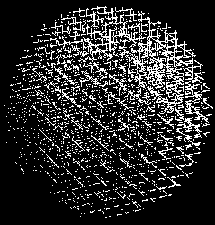
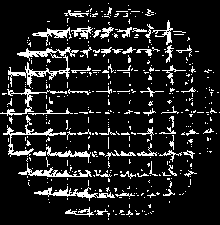
Fig. 1: Positions
and Perspective, not only models, guide perception and create transparency or anxiety.
Morellet Sphere, Rive Gauche Gallery, Brussel, photo: A.J.N. Judge -
Many further examples can be found in the study of body language. Poses and gestures are
seen and interpreted quite differently when seen other perspectives.
2. Change the maps, models, and paradigms
Central dilemmas include the lack of
global or wholistic pictures, and oversimplistic flat paradigms. No doubt,
reductionistic, materialistic and hierarchical approaches have their merits and help for
many processes, but they can be easily misused and cause much harm when combined with
overclaims used in applications beyond their scope and validity. Western Industrial
Society for example seems to be lost in fixation on hierarchical representations and
nominalism. Complexity and Ideas and Images are screened out and everything is put into
the straightjacket of monontone hierachical and unimaginate 'orders'.
Representations like paradigms
are given paths. We typically use them in one domain to have a guideline to achieve
something or go somewhere. The knowledge tree and bibliographic classification systems are
only one example of how we avoid complexity by moulding it into linear and sometimes
oversimplistic orders. Such representations support a simple and easy to remember
structure, especially if computers are used to handle large volumes of data.
Typically they are easy to understand and are
even practical when used inside their known (often not consciously reflected) boundaries
or limitations. It would be silly to blame a map, model or paradigm for being
wrong but it is our linear and dualistic education and View-of-Life, which makes us blame
others when it encourages us to cultivate oversimplifications and overclaims, instead of
paying attention to underlying rules, ranges and limitations.
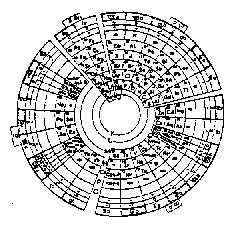
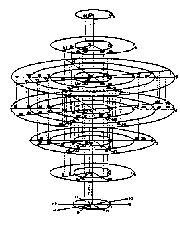
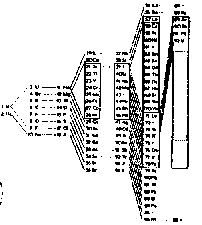
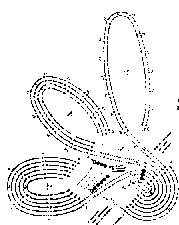
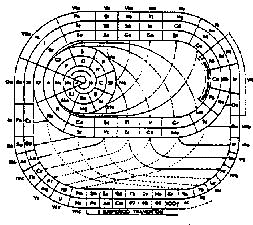
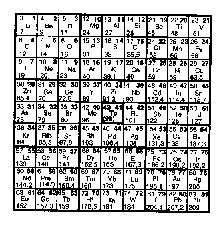
Fig. 2: Alternative presentations of the periodic table or layout of chemical elements
The above is a selection of pictures from Functional Classification,
Appendix 4 pp.1763, Vol. 3 Yearbook of International Organisations as reproduced in part
from J.W. van Spronsen, The Periodic System of Chemical Elements, a history of the fist
100 years, Elsevier 1969, and the display, the 'Magic Square' form a recently conceived
and published design based on number theory as published in: Michael Stelzner, Die
Weltformel der Unsterblichkeit " Vom Sinn der Zahlen " Die Einheit von
Naturwissenschaft und Religion VAP Wiesbaden, 1996, ISBN 3-922367-70-4. In chapter 3: The
Third Dimension, p 369-370.
The last model, the 'magic
square' matrix, is not typically known, or 'accepted', it might be even called
arbitrary by some scholars. Nevertheless, this new design is highlighted here to show that
there is an ongoing search for new models which are simple and complete and
insightful! AND which make sense for certain, given purposes or quests for
knowledge, open to being amended, improved or even discarded by further developments or
insights, earning acceptance in some eyes .. one day.
All these displays are arbitrary and have
their own validity and perspective/purpose, being coherent and fulfilling of those
purposes. They show the extent of knowledge, perspective or detail
called for at a given time, and in given frames, display a true picture according to the
objectives or course of discovery of what we know or how we master the art of mapping and
modeling of Nature. Most of the stages in finding a model of reality were faithful
and helped us to ask new questions and see new connections, in retrospect is the
epistemology of what and how we know something, even if we can not always appreciate in
the moment what is most exciting or revealing or important.
The matrix or a
three-dimension scaffolding can hold many different schema or orders. The work of Anthony
Judge and I. Dahlberg are covered to great depth in other publications, so we invite you
to visit the site of the authors and go to 'source' the original works (see in particular http://www.uia.org/webints/aaintmat.htm
and the overview and historical orientation article 'Functional Classification' by A. J. N.
Judge). These backgrounds indicate that we can design or construct deeper
logical and coherent orders. The agreement on such anticipatory schema to map items allows
us to switch between schemata and gives rise to much hope for bridging cultural
repositories and making available sources which now are hard to locate and access. This
gives much hope for further projects in the field of archiving and cultural
navigation. See in particular: Veltmann, K.H.: Frontiers in Conceptual Navigation,
ISKO Conference on multimedia applications, to appear in 'Knowledge Organization' early
1998.
3. Change positions and purpose to
relate/integrate/orchestrate
'incompatible'views, perspectives, and models.
The integration of such different views of
reality or nature is seen as an important step towards tolerance. It is simplistic
to make us aware that we only see different pictures of a reality, like entering a village
from different directions or looking from above or just out of a certain window or door
(frame). To create a complete framework of views, bridging all the scales,
perspectives and intentions under which pictures were recorded, will never be possible.
Yet it is possible through education and experience to create a picture of the
whole, keeping in mind the resolution and purpose of the 'frame-construction', and the
open willingness to question the construction, since different time or wave-lengths or
-widths might lead to different models and re-imaginations.
As there seems to be some
misconception about maps or matrixes (some considered widely authoritative or final),
we will show below -- or give reference to -- approaches to order and see in one
image a coherent layout of indexes of data or knowledge under a given perspective. The
difference between any scaffolding, matrix or layout to the following two classification
schemes can be assessed by the following criteria:
1) Is the layout simple, easy to remember, logical, coherent and complete?,
or,
2) is it
far from any organized higher order only a mess or chaos of data?
Figure 4 is a matrix proposed
15 years ago for providing an index for knowledge ideally suited for library access, even
in different languages, allowing to switch between or link other classification schemes.
Figure 4 is a system conceived to keep the inner and higher order as far as possible in
mind, but compromising for the sake of specific applications and purposes.
Functional Classification, Figure 3b was developed to index and update large volumes
of data from International Organizations. We refer you to example literature like the
overview articles of A.J.N. Judge on Functional Classification, and the work of this
author in multilingual, meta-databases, terminology and harmonization projects: link
<**>. Please note that other representations, besides the well established
hierarchical tree-structures, are readily available and feasible for data storage and
retrieval, notably in multilingual, multi-cultural, and interdisciplinary areas of
applications.
A Universal Ordering System
An Integrative Matrix
for Disciplines and
Phenomena
of Human Preoccupations
| |
Matrix columns |
Matrix levels |
|
Matrix columns |
Matrix levels |
|
|
9 |
Culture |
Distribution and Synthesis |
|
9 |
Condition of the whole |
Experiential (modes of awareness) |
|
|
8 |
Science & Information |
Application and Determination |
|
8 |
Environmental manipulation |
Experiential values |
|
|
7 |
Economic & Technology |
Technology and Production |
|
7 |
Resource redistribution |
Innovative change (context strategies) |
|
|
6 |
Socio |
Institution or Content |
|
6 |
Communication reinforcement |
Innovative change (structure) |
|
|
5 |
Human |
Persons or Content |
|
5 |
Controlled movement |
Concept formation (context) |
|
|
4 |
Bio |
Property Attribute |
|
4 |
Contextual renewal |
Concept formation (structure) |
|
|
3 |
Cosmo & Geo |
Activity, Process |
|
3 |
Differentiated order |
Social action (context) |
|
|
2 |
Energy & Matter |
Object, Component |
|
2 |
Organized relations |
Social action (structure) |
|
|
1 |
Form & Structure |
Theories, Principles |
|
1 |
Domain definition |
Biosphere |
|
|
0 |
Subject Areas |
General Form Concepts |
|
0 |
Formal pre-conditions |
Cosmosphere/Geosphere |
Fig. 3a
Fig. 3b
Information Coding Classification
Functional Classification
I. Dahlberg (c)
A.Judge
The above are only two from
many possible ways to structure knowledge in a coherent and meaningful way. It is
important to realize that many further matrixes or maps are possible and feasible. What we
learn from these exercises into ways of structuring information is, that 1.) we have
to look for coherent, transparent, simple and easy to remember layouts, 2.) they
solve real needs, get applied and make data available, 3.) they create, logical unique
locations for entries for the sake of reducing the volume of redundant information, and
4.) they help people to understand connections, make sense, and see the whole.
It is important to understand
that 1.) regarding depth of information, a coding up to 5 or more digits helps to
structure with a much finer 'granularity', that 2.) ontologically- based general concept
systems allow to implement a 'Systematifier' principle (Dahlberg), what Judge calls a
'Structural Outliner', that 3.) such systems can be implemented as 'switching systems'
which enable re-coding and translation between other, typically hierarchical and
proprietary classification schemes, which are typically found in different libraries, and
4.) that there is a possibility to use such schemata as the backbone for multi-lingual
information and classification systems, as languages can be considered to be just another
'level' (see more about this in Figure 5). All these features can help build
conceptual bridges in order to roughly identify something in other cultures and languages,
enabling translation, when appropriate.
The first matrix, the ICC,
was developed for library sciences and has another unique quality: inner or higher order.
The second matrix (FC) is more of an experimental nature, subject to changes, as
application and production requirements suggest. When looking closer, we see that the
realm of the second matrix is much wider, but both like many possible others, have their
purposes and find their place.
We show the partial detail
these two scaffoldings to make aware the potential for outlining themes in a holistical or
complete and coherent sense. This is a compromise but it has distinct advantages over the
traditional hierarchical 'knowledge-tree' structure because they provide knowledge-spaces,
which can be outlined, visualized, and embodied. Behind this is a quite different
handling of words, taking words into space as the Australian Linguist proposes or as the
father of holism, Jan C. Smuts has proposed by considering and manipulating words like
fields in space.
For more, see ISSS Primer WHOLENESS Seminar: http://www.newciv.org/ISSS_Primer/asem09js.html
Area/
Form/
Concept |
theories, principles |
object, component |
activity, process |
property, attribute |
persons or content |
institutions or content |
technology & production |
application & determin-
ation |
distribution
&
synthesis |
| form & structure |
11 logic |
|
|
|
|
|
|
|
|
| energy & matter |
|
|
|
|
|
|
|
|
|
| cosmo & geo |
|
|
33 geo-
sciences |
|
|
|
37 mining |
|
|
| bio |
|
|
|
|
|
|
|
|
49 ecology & environ. |
| human |
|
|
|
|
|
56 education |
|
|
|
| socio |
61 sociology |
|
|
|
|
66 law |
|
|
|
| economics & technology |
|
|
|
|
|
|
|
|
|
| science and information |
|
82
information sciences |
|
|
|
|
|
|
89
semiotics |
| culture |
|
|
|
94
fine arts |
|
|
97 philos. |
|
|
Fig. 4: A matrix
organisation of subject fields called the ICC, Information Coding Classification system.
A survey of subject groups or a new universal ordering system for
disciplines and phenomena. The schemata conveys not only the sense that a holistic
organization is possible - with broad categories in which to organize and relate diverse
integrated systems - but that given sub-systems can be members of several cross referenced
categories (as described in vernacular in J N 's "Understanding
the Integral Universe"- Introduction (1992)).
Please note, we do not
show the content of each cell, or how they are coded, merely samples given. You can
find more about this grid and about ongoing research projects in this field here [ webmaster note: link
temporarily inactive]. More importantly, this scheme is there
to help you look for yourself, ask new questions and find new structures and
relations, which is essential for creativity. For the purpose of this paper we
only show that we can tune our thinking to look for coherence and connectedness. This is
mandatory in order to avoid the redundancies we are confronted with today -- in an era of
confusion and overload of messages with dubious value.
I see such a grid as
one possible way of making sense for a given purpose or certain aspect, then we can show
connections and identify not only a cell, but columns or area consisting of a couple of
small parcels of 'land'. In this way we can outline and search for subjects and
issues more coherently! We will find out that some cells have relations with only few or,
as in the case of the term ecology for example, we could define relations with nearly
every other cell and can in this way detail it in a meaningful way. The following
are only some examples in the broader 'area 49' of ecology and environment: 4951:348 air
pollution, 4925:428 marine microbiology, 4938 garden and parks architecture,....
4. A Navigation
and Orientation Space
Finally, a Navigation and Orientation Space to embody
Situations consisting of each of the three dimensions in three connected spaces: This can
be understood as the Japanese bio-holistic 'ba' concept for inter-spaces. There is a need
to index and find real and conceptual entities and to find ways to present such in
coherent layouts.
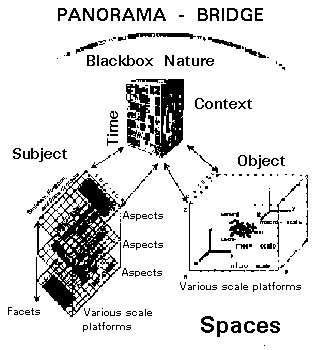
Fig. 5: The Cognitive Panorama, in its
limitations, is one of many possible candidates. There is also a need for the coexistence
of different forms of representation and an easy transformation and translation between
the different models, foci, and forms. By combining and overlaying such representations
annotations new connections and insight might come up and canyons between objects and
subjects will be bridged. see details about the Cognitive Panorama Bridge at
http://newciv.org/cob/members/benking/benking.html
and http://www.newciv.org/ISSS_Primer/asem09js.html
There is a definite need for
simple, coherent and open models acting as common frames of reference, in order to
accommodate diverse perspectives and teach tolerance, coherence and harmony. In particular
the Western Societies, seem to be fixed or blocked in their way of seeing the world. They
neglect the issue of the need for models to aid our thinking and sharing references.
Instead modern societies opt for having no model or WORLD -VIEW at all! As
this is the result of 30 years of education into 'Subjectivity', every thing is seen as
relative and vague. We should not wonder that this resulted in the cultivation of
'self-esteem' and ego-develoment, instead of building society on confident children having
and changing directions and orientations.
One final remark is in
order. In the "Cartographer of Consciousness" by Brian Van Der Horst,
.."Ron Siegel probes the hallucinating brain to chart hidden features of our mental
landscape" Omni, Sept. 1980, the author uses Heinrich "Kluver" to
present a geometric recursion. There is much research going on in this field (which will
be covered elsewhere). For this little journey along maps and representations it can at
least give us the idea of connectedness of physical and mental realms. The only problem is
our problem of believing in one 'authoritative' map or matrix, the one and only school or
'dogma'. The presentation of the chemical elements proved that there are many views and
schemata possible and even they all together are just maps, not the territory, as Alfred
Korzybski wrote.

Fig.6: Form constants as mapped by the 'cartographer of
consciousness'
5. Bridging and Sharing
Positions and Identities
As many question arouse about the variety of basic representations and which ones are
"right" or "wrong" we feel it is necessary to show that these way to
present are to be found in many cultures. As words do not suffice here another
pan-cultural schema, the "Four Shields" which was developed by Steven Foster and
Meredith Little form the School of Lost Borders, Box 55, Big Pine, Ca 93513, as based on
various sources they have selected and combined over the years in order to provide even
for our generations and societies coherent and meaningful ways to find oneself, as an
individual or in and as groups.

Fig.7: Vision Quest - The Four Shields
We can see that such representations are deep, you can zoom in for more
detail and meaning, just as the "symbolic tree" of system sciences. So
what we need to be aware of is that we have here a general overview or context, and that
there are connections between the different forms and structures. If like in the Indian
"shield" we can see that forms change in time, when we can establish a flow from
one form to the other, and if we can position ourselves, creating places for a me and the
various forms of we, than we have been arriving at another level. The possibility to look
for change and exchange.
Such "wind-s" or systems of "basic elements" can be found in many
cultures, the flow of action or change is sometimes clock-wise, like above, or follows a
rhythm or sequence like in the enneagram, or is "just" happening between
potential partners in any sector, like in the SYNCON's "Wheel of
Transformation" where different partners or potentials can find to each other, or
the Shadowy Round Tables
of Anthony Judge, where we realize that there are not only positions and polarities, but
that they can keep themselves in "Checks and Balances", that element belong to
each other and only when all aspects are there we have a whole and can change the aspect,
focus, priority,.... we can hope to get a little closer to the challenges of comprehension.
6. Inhabited
Extra Dimensions
For presenting change in a vortex or any other form we have to add another dimension, an
extra dimension. In this case the "wheel" or "shield" can be seen on
different levels or for different persons at the same time.
One very special application is the possibility to group items or issues on the surface of
a "ball", a platonic solid, or on a "tensegrity surface" as is shown
by Anthony Judge a "A Complementary Perspective". To further detail we see
in Patterning Problems, chapter 5
that we can for example configure patterns of problems in (a) Grid representations, (b)
Other two-dimensional projections, (c) Spherical projections, and (d) Unconventional
surfaces representations. This can help us to go deeper into issues and share how things
are related.
The problem is clear: As some Indian tribes say "we all share one
skin", we all have something in common, we are suddenly confronted with realities, we
can not readily touch and feel, but have direct impact on our living situations. I have
repeatedly presented that we now "not only
share on skin, but many skies", and that there are dangers in getting lost when
we live in different "realities" and even more are liable to fight as we think
we know and are right.
As so much work is done already to show us how to go beyond the over simplistic dialectic
or dualistic representations and how they are interwoven and need "embodiment"
(see only as a starter from Anthony Judge: "Liberation
of Integration, Universality and Concord through pattern, oscillation, harmony and
embodiment" or "The
Territory Construed as the Map - In search of radical design innovations in the
representation of human activities and their relationships") we want to subscribe
to the need to find new ways of showing functions and relations, patterns, proportions and
consequences.
Buckminster Fuller's and Judge's tensegrity structures are extraordinary and have received
much interest lately but what we need to remember is that we have to find ways to
represent in ways which are simple and easy to remember. Thinks we can recreate and
generate ourselves, make scribble and explain to ourselves and others. So what we have
presented in chapter 1-5 of this article was the design of a "conceptual
architecture" like the Viennese Architect Adolf Loos (1870-1933) saw that design has
to follow social needs and that we can think in 3 dimensions to better accommodate the
relations and neighborhoods, create better living environments. So what this paper is
about is showing that we are not restricted to the "flat" 2-dimensional grids as
in (a) of Patterning Problems of Judge above, but that these grids are good and stable and
easy to remember and we just have to add other levels, stories, ceilings, floors, whatever
you want to call it in the "House
without Walls", in order to create also "sound conceptual living
environments.
7. What for? Why take the trouble?
Adding other levels and immersing into an "extra dimensions" has a lot of
advantages, if the representations like the "Wheel" above do not suffice. Again,
if we can manage with a simple and flat schemas, like the "Vision Quest" or
other "wheels" are doing to help people find themselves or help them to gather
answers to steer their life, that that is great and sufficient, we should not bother any
longer. But unfortunately there might be a need to accommodate checks and balances also
when paradox, and different times, different cultures and technologies are involved. In
this case we might need to widen the platform of discourse, the space we can negotiate.
It was necessary that the ways we construct images are connected, that there are basic
"form constants", that they can be found in many places, and that we do not
restrict ourselves to grids or spheres or vortexes.
The issues is and was: What is the most convenient and easy to remember? Does it provide
overview and orientation, is it possible to "re-member"?, without a
device"?, is it simple, open, coherent, and complete?, is it close to our thinking,
along with our "human potentials to imagine a scene and to move in artificial
"themescapes"?
As we can see the extensional directions, right-left, up-down, forward-backwards are basic
for orientation, and feeling, gripping and grasping as closely connected we feel it is
important to make sure that we do not loose ground and touch, even when reasoning.
It is so common place to be abstract and pointlessness in our times, that we have lost
much of the capabilities to share and have em-pathy. We therefore point as often as
possible to locations or work where these fundamental "capabilities" are
focussed on.
To begin with here three "locations" which focus on the basic capabilities we
are referring to: 1. MetaSelf as a course book to
study spacial-placial awareness, as created by an artist, 2. an "e-book"
electronic book available freely on the web done by an engineer who used to build robots,
but has taken up this leanings to reflect about communication, senses, and reasoning. It
about how to re-learn and re-discover how basic thinking processes work and how taking on
another perspective helps to see things in different new light.
A General Learner. As thinking
has much to with having a body and a position (from which to think) we cannot stop without
making a last, 3rd recommendation. It is a link to a Foundation for Sensory Awareness. We have
found it through the work of Elsa Gindler and Heinrich Jacoby, body therapists and
educators, who have made clear how much we are rooted in our body and that we do not
understand and can not share meaning when it is abstract, when it is not
"touching".
All this is written to make us aware that when we speak about body, field, area, or
range when we actually try to re-create and imagine as authentic as possible
a body, field, area, or range of any issue, entity, situation, or pattern. This
does not mean that we see all details volumetrically at once. But it is good to have a
floor-plan or a scribble. We still might not be able to create all sections - but it is
good to know that we could create sections, as there is a known - agreed upon - design.
We have shown above that spacial and placial metaphors can help us to share meaning.
But this is not enough. The moment we agree on locations and places, we gain positions,
directions, identities. And it is good to be able to mark where we are and where we want
to go....
8. The "excentric positionality" (Plessner)
and
Shared Realities and Imagination
The moment we are willing to agree on a map or design we can relate positions, see how
they are different and how we can change our views by standing somewhere else. The basic
stumbling block has always been to be fixed or locked into something, to be
"framed" into someone else's "grid", "cell",
"territory", or "category". To avoid this - being flexible - the
ultimate goal is to extend one's mobility, to move along and across "scales" as
we say in ecology, even map flows and energies.
Such an ability to position and map allows us to see things in perspective, be able to
step back and be able to merge and morph views as has been pointed out before at 1. (metaphors) and 2. (house or
conceptual superstructure).
We arrive at the human potential not only to move, but to move with our ideas. Move in
two worlds, not only the material, but the "ideal" and conceptual. This unique
capability to identify, outline, and move beyond areas and boundaries is the unique
capacity of humans: We do not know if and how far the capacity is available also in the
animal kingdom, but we know that one of the most eminent and deep philosophers, Hellmuth
Plessner, has exactly focussed and expressed this capacity to outline and transcend, not
to be fixed in one position, but to relate the various possible levels of being, move
beyond duality.
Creating and Living in Space is the basic step to go beyond duality and over simplistic
hierarchies. Space allows us step out of the plane, to step out of the dilemma of being
forced to say yes or no, by stepping out we gain distance and perspective and can even
realize that the different views are just different angles under which we might even see
the same object. This is all very easy the moment we map meaning in space, locate actors,
scenes and issues...
What we have shown here is that it makes sense to think in space, give meaning a place ,
and walk around it. The author has embodied Plessner's "excentric positionality"
as we need to model and embody such things in order to share it with others. In this way
we can come to broader basis, better understanding as we do not get entangled in abstract
words with out shared meaning. We propose to look at the schemas of being-feeling-thinking-healing,
how we extend our realms of activity and imagination.
This has much to do with our way of reasoning - how we use metaphors and paradigms - how
they mold our given pathos. We have show elsewhere that paradigm is just way ot thinking
in a given framework, let us call it domain or culture. If we map these ways, then we see
which fields of expertise we make use of and which concepts we employ. If we have a
grid of concepts or functions, then we can suddenly see how we always re-invent the wheel
instead of being creative. So let us call a paradigm a "fixed" way of thinking
or reasoning". This is helpful to make some distance, but this is also boring and
non-creative. By mapping the different paradigms on the same map, we see where they are
comming from, what their base or expertise is, and where there are heading to.
this context or background of data or information is called meta-data or
meta-information. So we called the background of a paradigm a meta-paradigm,
a framework or model of being and sharing. The moment we can map and position we can
compare and relate. This is often done unconsciously, we call it creativity when we
oscillate between different modes and compare and match "patterns that connect"
(G. Bateson), it was also called lateral thinking (deBono) and it was called
"diagonal thinking" as it is done across planes and levels and it is actually a
typical German word querdenken, or as a known Querkopf. Always implying that you leave the
given mold and try something, new be inventive and creative, and are up for trouble in
order to overcome and learn from it.
Epilogue
We hope to have shown that there is no single and right or wrong schema, map, or model. We
might be right or wrong by choosing a particular one, just as Anaïs Nin wrote: "We
don't see things as they are, we see things as we are."
We also tried to show in this paper that there are good reason to have ego-centric,
eco-centric antropocentric or whatever views. They are good and helpful, depending on what
we need them for, what values, motives, assumption are behind them and to be able to speak
and reflect about them more easily.
The work presented here is the work we did with children, so the credit belongs to them:
We did ME&WE models in order to map where we are, in which world view, what something
is about and in it, ... to the result to have more understanding and humility the more we
gaze. Another result was tolerance and tolerance towards intolerance: no need to fight
other peoples opinions or statements. Instead sharing with them where they stand, what
they see and feel..., where they are in the cycles of being and becoming (see figure 7 -
the 4 shields) and that it is a matter of the times or where one wants to be!
We have called it peacemaking in our dialogue processes (in
German we call it Gespräch, Erörterung, and Mediation) Going with someone to the
"Ort" (thematical place=topic), negotiating with him/her the conceptual terrain
and finding solutions, beyond dilemma, paradox, checks, and balances, by just visiting the
"conceptual "Ort"-locus or place and negotiating alternative ways. Tactics,
and strategies.
Final musing:
The central problem of our Society is our ruling one-dimensionality (duality) of our
thinking and acting and the apathy or aggression resulting from feeling 'lost in space'
instead of resorting to our original capabilities of path-finding, bridge-building and
barriers-editing.... As we do not question representations and look behind words
(nominalistic instead of conceptualistic thinking) we do not switch codes, translate or
transform meanings. We are fixed into one perspective, instead of looking into sharing and
questioning. Only when we dare to tell and show our Children, that 1.) we also
do not know and that there are things which are 'unknowable', when we 2.) take them by our
hands and explore with them the INTER-SPACES, the terrain in-between the pictures or
landscapes, and when we 3.) jump and edit 'fences' and explore new levels, we will
reach new shores of social and ecological consciousness by bridging meaning,sharing
understanding, in what we called a meta-paradigm,
a framework of being and sharing. <http://newciv.org/cob/members/benking/benking.html>.
Acknowledgements: It is clear that without the work of Dahlberg, Judge and
Veltman this work and progress from harmonization of environmental information, to
meta-databases, education and and policy making would not have been possible. As there is
a strong relation and much material is used, in particular from Judge, the question of
integrating and providing a collage of the work of others is the right thing to do. The
author felt it is not only important to link and make known this work but combine it and
and create through the 'umbrella' of the panorama something new, maybe a step towards more
synthesis and synoptics.
The work of Mrs Dahlberg is only available through ISKO and its publishing house INDEKS,
Frankfurt and the Journal Knowledge Organization - KO. For visitors the author can
recommend not the introductionary article of Anthony Judge on Functional Classification and the work
of Kim Veltman from the Perspective Unit of the
McLuhan Institute in Toronto.
END
Whoever imagines mental barriers which actually do not
exist
and then thinks them away, has understood the world.
As space is entrapped in geometry's network of lines,
thought is caught in its (own) inherent laws.
Maps make the world comprehensible to us;
we are still waiting for the star-maps of the spirit.
In the same way that ambling through fields
we risk getting lost, the spirit negotiates its terrain.
Friedrich
Rückert , "Wisdom of the Brahmins"

Links
| Integrity /
Ceptual Institute Homepage |











